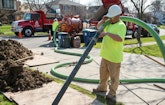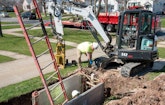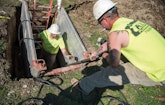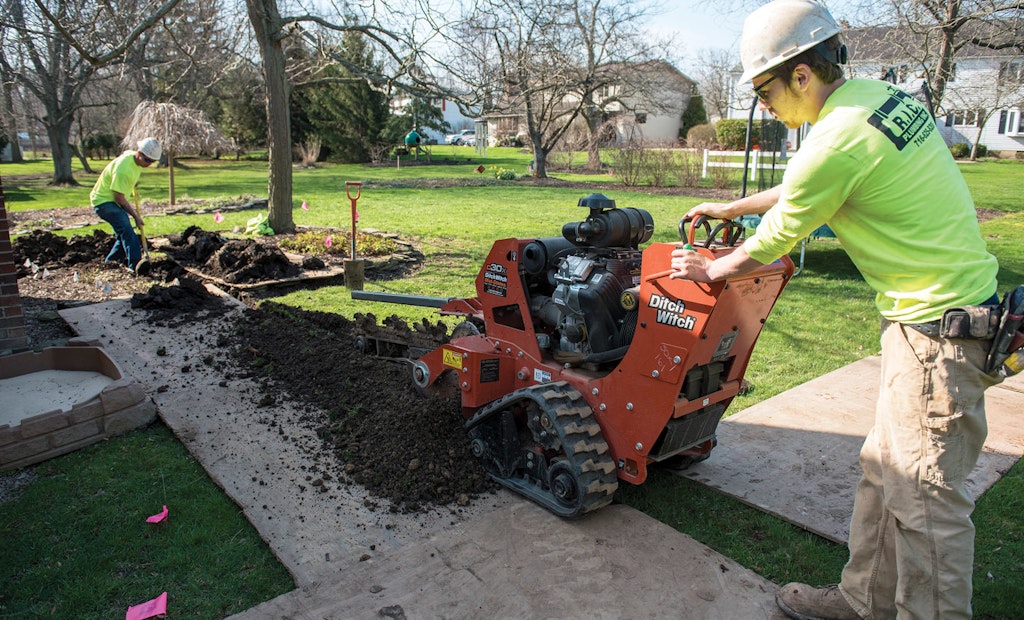Residential. Industrial. Commercial. R.I.C. Plumbing pretty much does it all, but it was underground work that really elevated the company.
Rick Kuhns was focused on plumbing when he started the company in 1982, but since his sons Scott and Adam came on board, the company has put a greater focus on underground work while expanding their business across western New York state. The Lockport-headquartered company sustains steady growth by building on its professional reputation, with a willingness to innovate and do great work.
“We want to keep the quality of our work as high as we possibly can,” Adam says. “I tell a crew if a job takes a day or two days, fine. Do the job to the best of our ability. Keep the craftsmanship up. The most important thing for us is our reputation.”
The good name of the plumbing house began to form shortly after Rick graduated from high school. As a high schooler in need of spending money, he had worked as a summer and weekend laborer for a friend’s father, who was a master plumber. Upon graduation, Rick formally began his apprenticeship. In ensuing years, his work ranged across the gamut of plumbing tasks, including factory work as a pipe fitter. In 1984, he became the youngest person to that date to earn a master plumber license from the city of Buffalo.
But, as entrepreneurs are wont to do, Rick became disenchanted working for others and started his own company. Relying at first upon some at-hand residential remodeling, he then took on commercial jobs and finally — after the factory called him back as a contractor — industrial work. (It was his wife, Karen, who took note of the range of jobs and matter-of-factly suggested the R.I.C. Plumbing name.)
Growing the family
Today, the company is a far different plumbing house. It is a two-generation family firm that has developed specialties around the interests and skills of the family’s three master plumbers. Rick’s son Scott, like his father, got into plumbing work as a high schooler and became a full-time company man in 1998.
“Dad had bought a backhoe a year or so prior to that,” Scott says. “We lived in an area where a lot of infrastructure was aging, and doing that work became a viable thing. I really enjoyed that end of the work.” It was the beginning of the company’s shift in focus from pipes in buildings to pipes underground.
Then Adam joined his brother and father at R.I.C. Plumbing. It was not a long-anticipated move for Adam, who was schooled as a chef. Professional kitchen positions were scarce, however, and Adam was not inclined to relocate from the Buffalo area. Furthermore, he had met his future wife. “I wanted to buy a house and I needed a steady job, so I joined the company.”
The culinary industry’s loss was plumbing’s gain. “We work well together,” Adam says. “We each have our own understanding of what we are good at. Together, we took the business a little further. The need in our area for underground work was growing. Scott and I were good at it and our employees enjoyed doing it, so we pursued it. It really worked out. We developed a really nice mix of sources of income.”
Two and half years ago, Rick moved laterally to become vice president of operations. Scott became president, and Adam, vice president. In all, the company employs 14 people, including secretary Elizabeth Nasca, who is the social media specialist, and Melanie “Mel” Lisiak, a friend of Rick’s grandfather. She helped Rick set up his office 36 years ago. “She was instrumental at the start and still is,” Scott says. “Mel is basically our grandmother.”
The feel of family runs through the company. Including the Kuhns, three father-son teams work with equipment and one mother-daughter duo work in the office, none of them related to the Kuhns clan. “We have a strong family ethic here,” Rick says.
Going underground
Scott credits his brother’s decision to join the company with a move to modernize the company’s equipment and better meet the demand of fellow plumbers wanting underground help. “We invested heavily in new equipment and new technology. Adam was a big part of upgrading our equipment.”
Before long, R.I.C. Plumbing became the company for industry peers to call for underground repair work. “Now we do work for a number of other plumbers who have solid businesses, but they don’t have backhoes and trenchers and excavators,” Scott says. “It has become sort of a niche market for us.”
The mix of equipment evolved along with the company’s focus. The original JCB North America backhoe was joined in the equipment yard by a Bobcat mini-excavator — and then a second one. Today, the backhoe, four small excavators, two trenchers, a Spartan Tool jetter, and a Ditch Witch FX30 vacuum excavator testify to the company’s subterranean mission. A 9-ton Case CX80 excavator is also in the mix, a midsized digging machine acquired to perform heavier work for a petroleum company and subsequently used for underground tasks for the Tops Friendly Markets chain. R.I.C. Plumbing also operates a full complement of trucks — three pickups, two small service vans, two larger sewer vans and four dump trucks — and several trailers.
Then there’s the smaller equipment. In 2000, the master plumbers recognized they needed a pipeline camera to really know what was going on down below and bought a RIDGID model, which still is in use. Four Vivax-Metrotech cameras are also kept busy, sometimes chasing frogs through pipes as shown in an amusing video on the company website — www.ricplumbing.com.
Breaking into bursting
R.I.C. Plumbing’s busiest pieces of equipment, though, may be its pipe bursting machines. At a trade show, the Kuhns plumbers saw a Pow-R Mole Sales pipe bursting unit and were intrigued. When a job subsequently came up that seemed an ideal candidate for pipe bursting, the company rented the equipment without much intention of being a repeat customer. However, a second opportunity arose and Rick suggested they invest in a machine. The company did, though Scott admits he wasn’t keen on the idea. He lauds it now. “It was one of the better moves we’ve ever made.”
The company now owns a Pow-R Mole PD-33 lateral pull device with a pull force of 60,000 pounds that can burst cast iron pipe (or clay, polyvinyl chloride, concrete, etc.) up to 6 inches in diameter. The company also owns Pow-R Mole PD-2 and PD-6 units, which are push-or-pull pipe insertion or bursting devices, and some auxiliary equipment.
Adam says after seeing Pow-R Mole’s products at the trade show, they became acquainted with a dealer in Lancaster. “They are in our area. The products are good. They are convenient. If we ever had a problem, we could resolve it the same day. If a machine went down, they would have another one right there for us.”
In fact, pipe bursting is now the biggest component of R.I.C. Plumbing’s business — two or three jobs a week. A recent undertaking involved an 80-foot-long 4-inch residential sewer line that had collapsed. R.I.C. Plumbing used two of its Pow-R Mole machines. A rod was pushed the length of the line, a cable attached and pulled back through and then new pipe pulled into place. The efficient task required two workdays. Still another tool — a Source One Environmental point repair system — is used nearly every day to fix pipes.
Having the right tool available for whatever task arises is a principle instilled in the company by Rick. From day one, he says, he taught his sons what he had learned early on: “If there is a tool that will help do a job more efficiently, buy it. There isn’t a tool out there that we haven’t bought or haven’t used. We are very aggressive on the amount of equipment we use on our jobs. It makes us very efficient at what we do.”
Maintaining quality
At one point, Scott began referring routine residential plumbing calls to other plumbers but soon learned that customers really preferred R.I.C. Plumbing because of its reputation. So two other master plumbers were hired for house repairs, complementing the two full-time underground crews run by Scott and Adam.
In all of this work, the company remains wedded to the Buffalo area, particularly Tonawanda and Amherst and other northern residential suburbs, though commercial and industrial work is undertaken almost anywhere in the region. The Kuhns are united in wanting to see the company grow, but not exponentially.
“We try to maintain a low trajectory of growth. For example, we average about one to 1 1/2 new employees a year,” Scott says. “We’ve had opportunities to go bigger more quickly, but we don’t want to. We want to manage our growth so the quality of our work doesn’t suffer.
Shoring up safety measures
Most of the underground work R.I.C. Plumbing performs is trenchless. It’s a big and growing part of the business. Yet even trenchless solutions sometimes require excavation for insertion of equipment.
Furthermore, in western New York, sewer lines are run relatively far underground to mitigate freezing problems in winter months. “The lines are deep, deeper than most people would think,” says Adam Kuhns, company vice president. “Our average depth is about 8 feet.”
OSHA requires that trenches or access holes deeper than 5 feet — or shallower if an on-site competent person has determined that a cave-in is possible — must have a shielding or shoring system in place to protect workers. Obviously, the OSHA rules come into play in many of R.I.C. Plumbing’s projects. As a result, the company has trailer space dedicated to carrying shoring components to job sites. “We carry shoring on a trailer with us on every job,” Kuhns says.
Construction job fatalities increased sharply across New York state in 2016, the latest data-reporting period, according to the U.S. Bureau of Labor Statistics. Most were not from workers being buried under collapsing trench walls, however, so going through all the trouble of unloading and setting up shields or shoring can be tough to justify by experience.
As for R.I.C. Plumbing, it invariably employs the safety equipment. “Once we decided to use shoring all the time, we quickly found it was worth it,” Kuhns says. “Putting the shoring in place seems routine now.”













